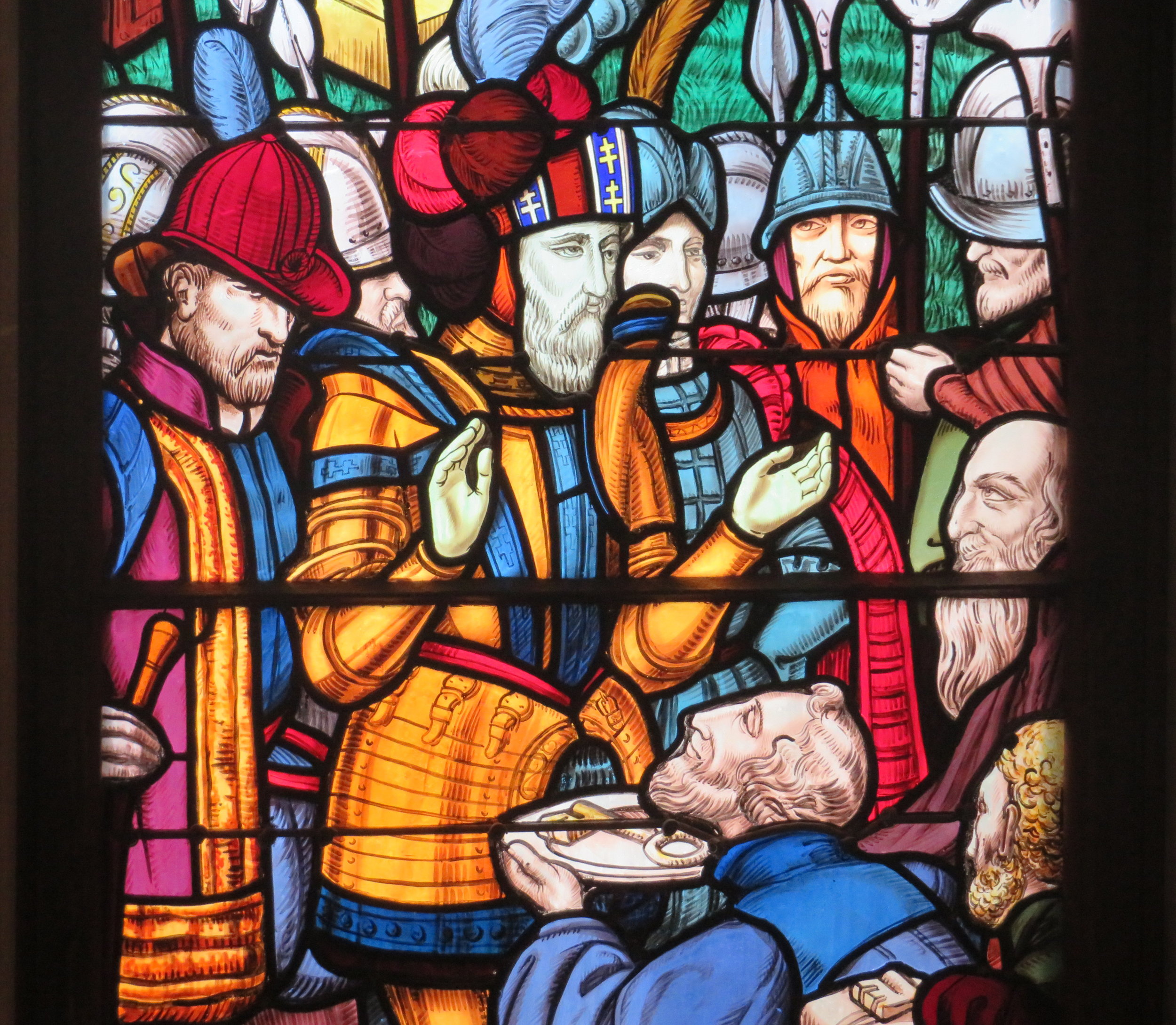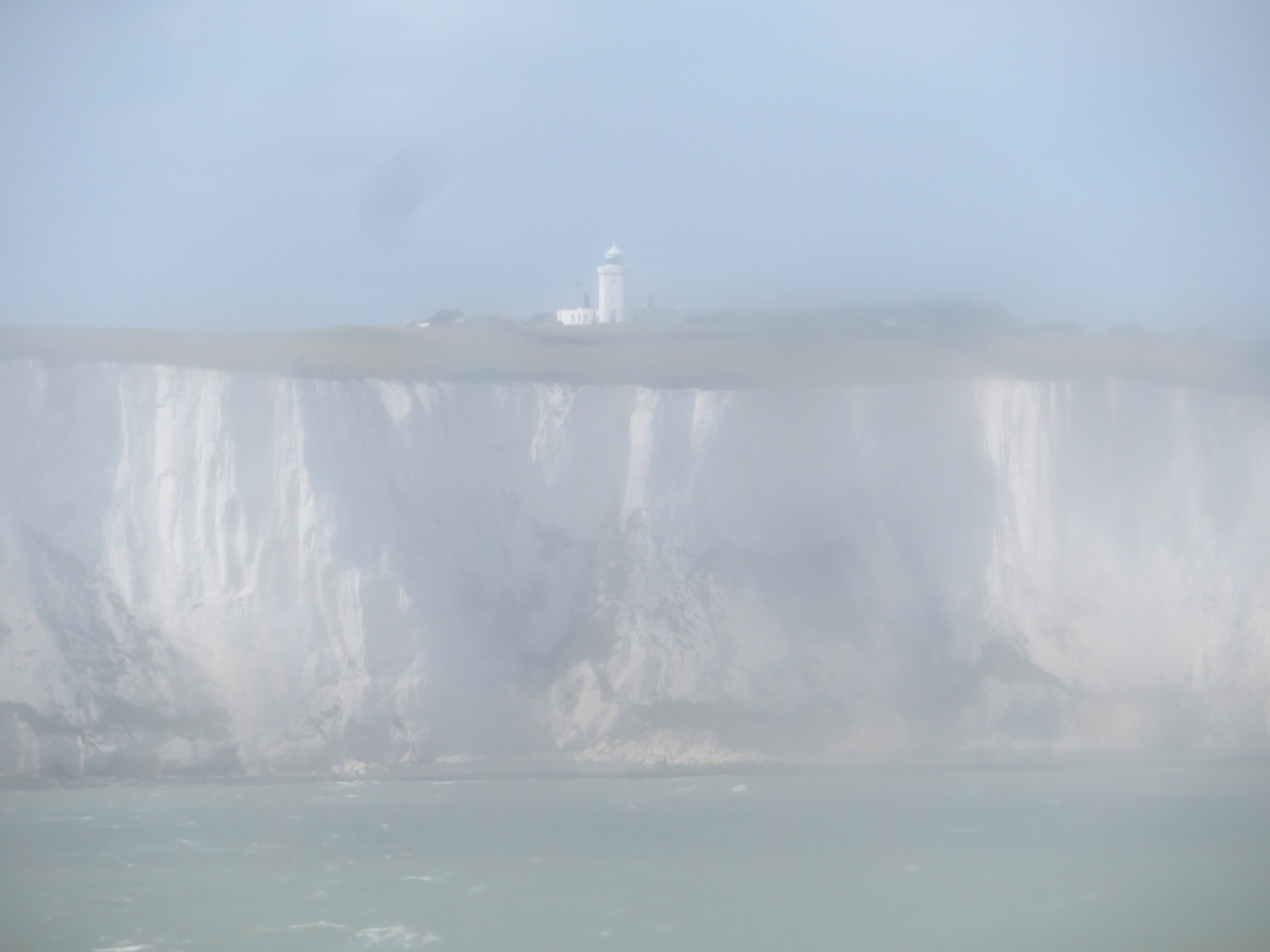Goodbye France, Hello England
/A Morning in Calais
We woke to the sound of seagull cries and the pelting of rain on the windows. The rain was more of a drizzle when we left our hotel, then soon became a downpour once again. We only had the morning in Calais and we had every intention of seeing everything we could see … rain or no rain.
Église Notre-Dame
We visited the 13th century Église Notre-Dame first because it is the end (or beginning) of the Via Francigena in France. Built during the English occupation of Calais, the church is a mixture of Tudor and Gothic architecture. It is unique in France for its English style. The church was closed, but it was the outside in which we were most interested.
A metal symbol on the church signifies its pilgrim heritage and its centuries long connection to the Via Francigena (VF).
A bronze marker embedded in the sidewalk outside the church is the ending or starting place of the VF in France.
We passed through Richelieu Gardens to view the statue of Charles DeGaulle and Winston Churchill, key national leaders during WWII. The fragmented sculpture of France regaining its original outline stands in front of them.
DeGaulle, Churchill and Lynn
A fragmented France regaining its original outline as DeGaulle and Churchill look on.
Despite the intermittent rain, the marché (fresh market), was in full swing.
The fishmongers were only too happy to let me take a a pic of them and their offerings.
We hiked in the drizzle over to Calais’ Hôtel de Ville, the city’s most famous landmark. Built between 1911-1925 (WWI interrupted its construction), it’s a splendid example of Neo-Renaissance/Flemish architecture. The exterior is very impressive with its 300’ brick and stone clock tower and belfry.
Calais’ Hôtel de Ville on a soggy morning
The inside is just as impressive as the outside with an Art Deco ceiling, grand halls, stairways and stained glass windows. One window, in particular, caught our attention. It depicted the recapture of Calais from the English by Duc de Guise in 1558 after a 210 year British occuupation. De Guise is shown presenting the keys to the city to King Henri II.
Though it was still rainy and gusty, we opted to take the elevator to the top of the belfry for panortamic views.
It was windy and wet on the viewing area of the belfry and except for our guide, we were all alone. On a clear day, the White Cliffs of Dover are visible, but not today. Nevertheless, the views from our birds nest high above the city were awesome.
Les Bourgeois de Calais (The Burghers of Calais) by Auguste Rodin
When we finally left, the rain had stopped and the sky was beginning to lighten. The gardens in front of the Hotel de Ville are quite lovely. A bronze statue, Les Bourgeois de Calais (The Burghers of Calais) by Auguste Rodin memorializes the bravery and sacrifices of six burghers (city leaders) of Calais at the end of the Hundred Years War. ‘Rodin followed the recounting of Jean Froissart, a fourteenth-century French chronicler, who wrote of the war. According to Froissart, King Edward III made a deal with the citizens of Calais: if they wished to save their lives and their beloved city, then not only must they surrender the keys to the city, but six prominent members of the city council must volunteer to give up their lives. Unbeknownst to the six burghers, at the time of their departure, their lives would eventually be spared due to the intervention of Edward’s queen, Philippa. Twelve bronzes were cast from the original mold, four of which reside in the USA in Philadelphia, New York City, Washington D.C. and Pasadena.
Across the English Channel
After the Hôtel de Ville visit, it was time to collect our backpacks from the hotel and begin our walk to the ferry terminal. Though Archbishop Sigeric took a ferry from Dover to Wissant back in 990AD when he crossed, the port of Wissant has been silted in for centuries and Calais is the port from which the ferries depart across the English Channel for Dover. We passed through both French and British Customs/Immigration stations before boarding the ferry. Not a word was said about our being in the EU beyond the 90-day limit and we breathed a small sigh of relief as we climbed aboard the bus that took us to the ferry dock.
It seemed most appropriate that the Spirit of Canterbury would take us across the English Channel to complete our Via Francigena walk.
The 26 mile passage across the English Channel took ~90-minutes, cost £30/each (`$36.50/ea) and we gained an hour crossing into a new time zone to boot. Much to our delight, the sun was shining as we boarded the Spirit of Canterbury for our channel passage.
Unfortunately, the salt spray on the ferry windows interfered with picture taking and passengers are not allowed on deck during crossings. Hence, my photos were less than optimal.
Through the salt sprayed windows on the ferry, we could make out a blurry view of the White Cliffs of Dover and the Dover Light.
By the time we arrived in Dover, the weather was warm and sunny. The White Cliffs of Dover are stunningly white!
The White Cliffs of Dover are stunningly white!
We walked along a pedestrian path that paralleled the beach on one side and the cliffs on the other.
The beach at Dover
The medieval Dover Castle was prominently in view. According to Wiki, Dover Castle was founded in the 11th century and has been described as the "Key to England" due to its defensive significance throughout history. It is the largest castle in England. The site also contains one of Dover's two Roman lighthouses (pharoses), one of only three surviving Roman-era lighthouses in the world, and the most complete standing Roman structure in England.
Dover Castle
We headed directly to the tourist info office, the starting (or ending) point of the VF in England for a town map and pilgrim passport stamp, then stopped at The Eight Bells pub for a bite to eat and an end-of-walk pint.
There was no doubt we were in England when we saw this sign.
6 miles walked / 13,962 steps*
*The VF route does not include in its route the miles walked from l’ Église Notre-Dame to the P&O Ferry Terminal in Calais, nor the walk from the Dover Ferry Terminal to the start of the VF in England.
Next time? We’ll walk to Shepherdswell, then on to Canterbury where we’ll finish our Via Francigena walk. Come along with us to celebrate. It’ll be a momentous occasion and maybe just a little bittersweet. Join us for the final legs of the Via Francigena in England.






















